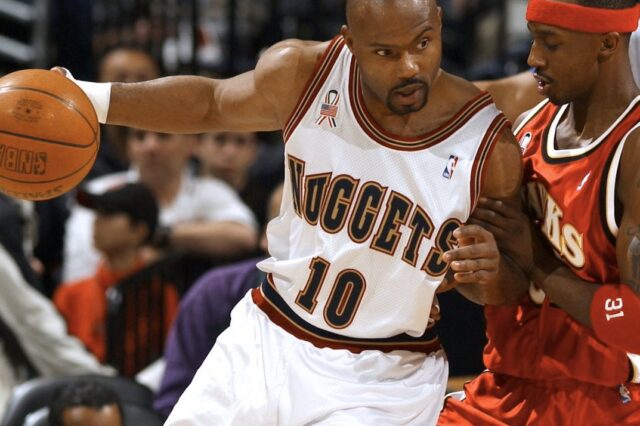This edition of Stat of the Week will focus on particular numbers that have been deemed the “four factors” of basketball statistics. Over a long period of time, the viability of certain metrics have been measured and deemed to have a degree of use in rating a teams’ performance, as well as their opponent’s. Four statistics have stood out from the pack, and they are:
- Effective field goal percentage: regular FG% manipulated by the three point line.
- Free throw attempt rate: how often a team attempts free throws.
- Turnover rate: how often a team turns the ball over.
- Rebounding rate: how often a team grabs a rebound.
Awhile back, I did a Stat of the Week on the viability of rebounding rate, specifically defensive rebounding and its effect on defensive quality, as one of the four factors, and the results were intriguing. Check that out here.
For this SOTW though, we are simply checking in on where the Nuggets rank on the offensive and defensive ends of the floor.
Four Factors – Offense
| eFG% | 51.8 | 14th/30 |
| FTr | .258 | 15th/30 |
| TOV% | 15.8 | 22nd/30 |
| O-REB% | 25.3 | 5th/30 |
Denver’s average rank for each category is 14th to this point, which reflects their 15th overall ranking in offensive rating (104.6). Where Denver gains its biggest advantage is on the offensive glass. Nikola Jokic is one of the best offensive rebounders in the NBA (2.5 O-REBs per game) for as often as he captains the offense from the top of the key, and when Kenneth Faried and Mason Plumlee are in the game, they crash the glass extremely well.
Where Denver struggles is with turnovers. Eight players average at least one turnover per game, and six players have accumulated at least 20 turnovers total in the first 12 games. With Jokic as a primary facilitator and struggles at the point guard position, Denver will likely always struggle with some decision making issues. Where they can be better is with committing the right kind of turnovers. Opponents are currently scoring 17.2% of their points off Denver turnovers, up from 12.6% a year ago. A product of that is Denver being better in the half court defensively, but the main reason is Denver is turning the ball over in the open floor.
Easy run-outs are free points for the opposition. It all starts by knowing where everyone is supposed to be on offense and executing the set. When that execution gets sloppy, or the floor gets too congested from poor spacing, these kinds of turnovers happen and can completely change the flow of a game.
I would like to see Nikola Jokic and Gary Harris try and get to the free throw line more often. Both can struggle with disappearing at times during the game, but by being aggressive and drawing contact, they can make up for some of the inefficiencies the team is having until Millsap, Jokic, and the rest of the offense figure each other out.
Four Factors – Defense
| OPP eFG% | 52.4 | 22nd/30 |
| OPP FTr | .231 | 6th/30 |
| OPP TOV% | 16.8 | 5th/30 |
| O-REB% | 23.8 | 21st/30 |
The defensive profile is interesting for the Nuggets, but the big thing is that the individual ranks average out to 13.5/30, meaning that Denver has produced an average to possibly above average defense to begin the year. That isn’t reflected in the defensive rating of 18th so far (104.2), but it could mean that there have been a few outlier performances so far (i.e. Golden State Warriors blowout, Brooklyn Nets garbage time, Toronto Raptors garbage time).
The most important factor on both ends, in my opinion, is effective field goal percentage. Denver has struggled with that so far, ranking just 22nd in the NBA, and that’s a sign that the defense may be worse than where they currently rank. Still, 22nd is a big jump from where they were last year (28th).
Another huge improvement is Denver’s ability to generate turnovers. Using a conservative defensive scheme last year, Denver ranked last in the NBA in forcing their opponents to turn over the ball. Frankly, it wasn’t even close. This season, they are forcing opponents into errors at the fifth best rate in the entire NBA. The four teams above them, Oklahoma City, Utah, Detroit, and Memphis, all rank top 10 in defensive rating. Three of them rank top five.
Gary Harris and Paul Millsap are the two biggest reasons for this improvement. Harris constantly digs in to the driving lane when other offensive players drive his direction, leaving his man for a split second to try and get a steal. Against good teams with good shooters, this strategy has some holes in it. Against bad teams or players that have subpar shooting, it works pretty well in causing confusion.
The other reason is that Paul Millsap is so damn good on defense. His rotations are on point, allowing the guards to freelance and gamble a bit more. When those players get beat, he’s usually patrolling the lane to come up with steals and blocks, forcing the offensive player to make a good decision. When they make good decisions, his impact can be mitigated. When they don’t Millsap can have games like he did against the Thunder where he picks up two steals and six blocks. Six!
The Nuggets aren’t a very physical team, and that’s reflected in the other two categories. They give up offensive rebounds to the other team at a pretty high rate, but they also don’t foul a ton to send the opposition to the free throw line. One bad quality, and one good quality. Not really surprising at this point.
That wraps up this edition of Stat of the Week. I will probably talk about lineup data in one of the next two weeks and shot charts for different players in the other. Let me know the preference in the comments or on Twitter.


